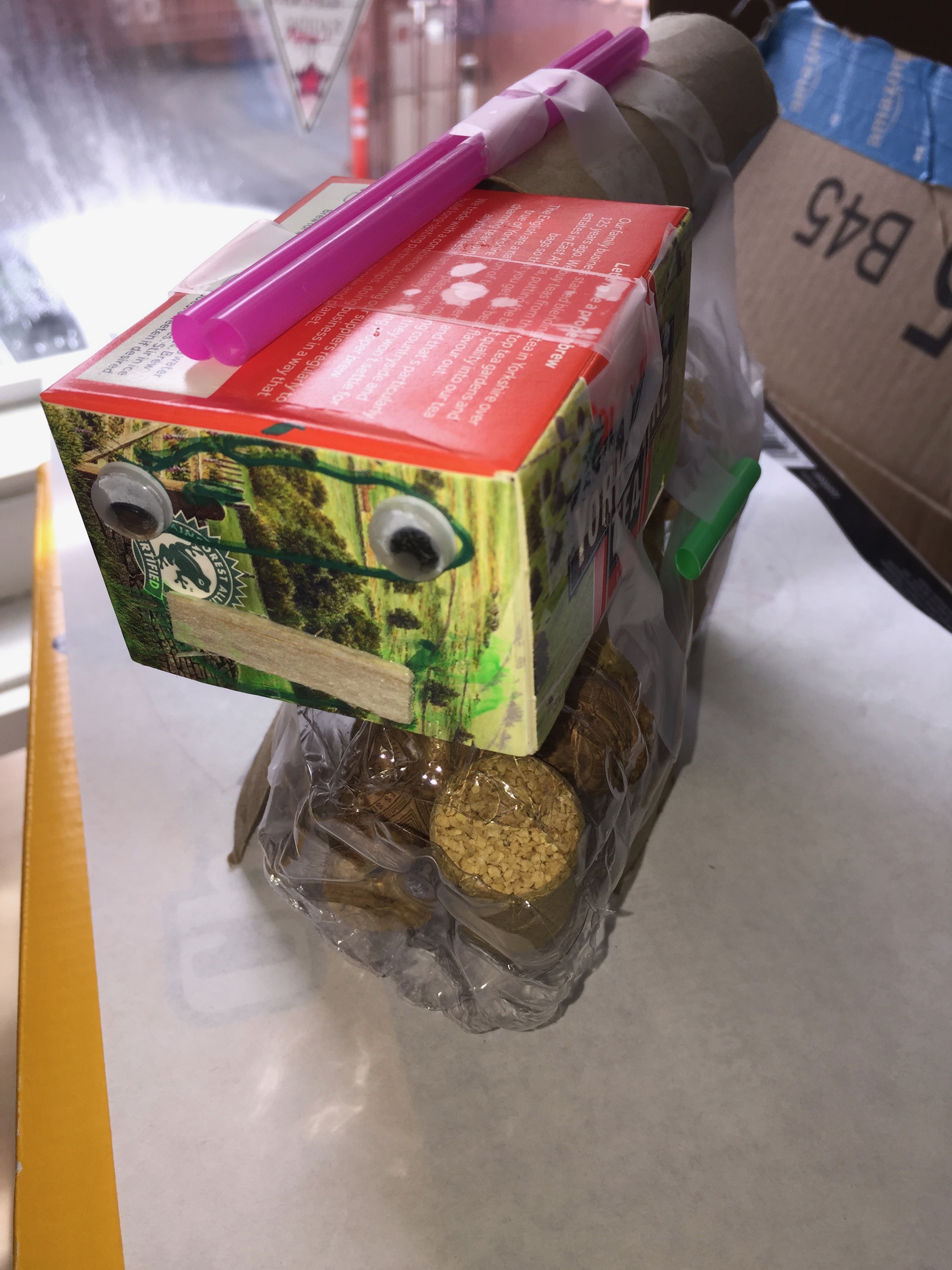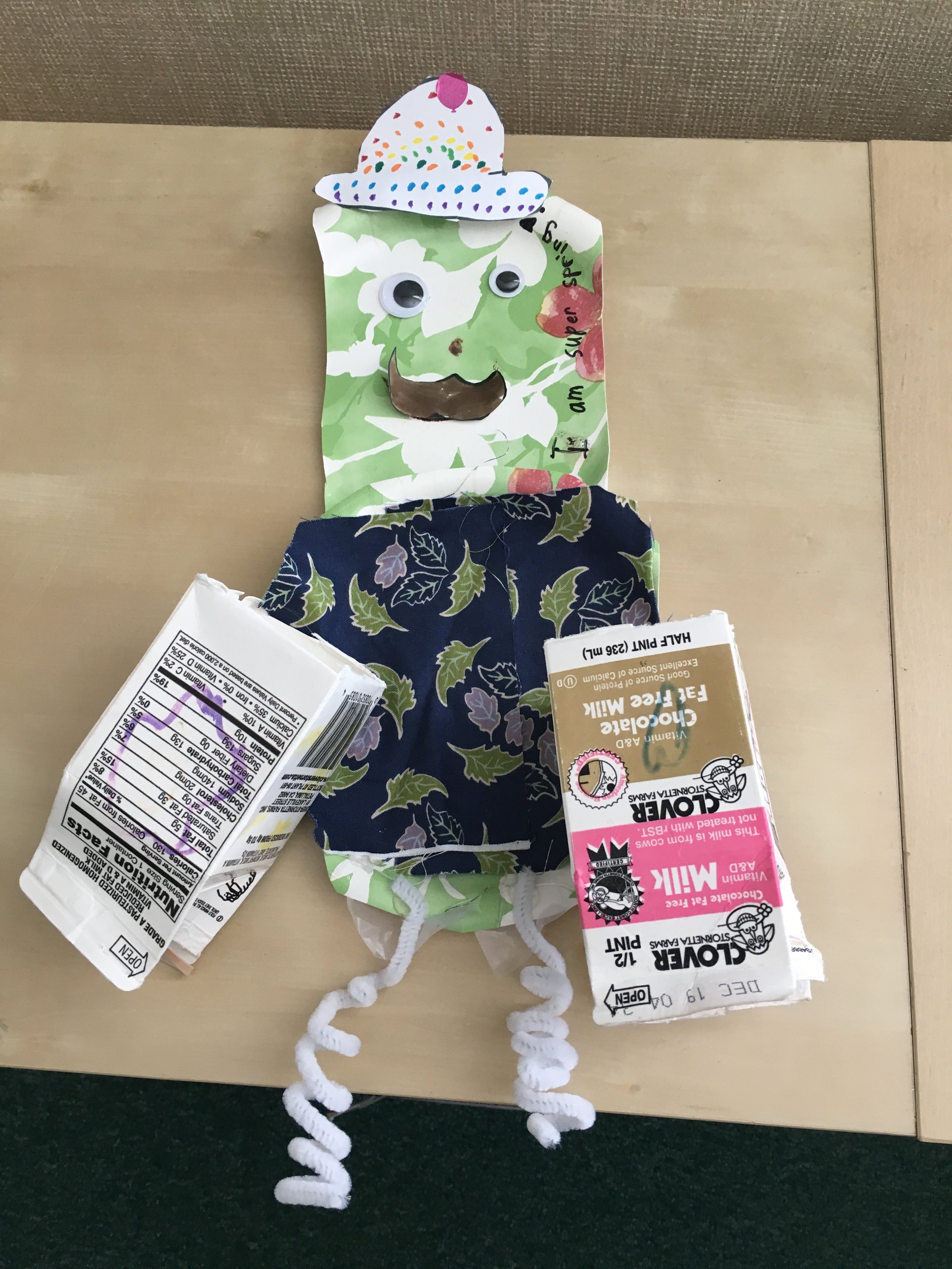Another Year of Astonishing Art for the Recycled Materials Art Competition
/The Second Annual Recycled Materials Art Competition is about to draw to a close, and the PaperSeed team has been blown away by the amazing art we've seen!
All K-5th grade students in Marin County were invited to join the fun, and had the month of April to complete their projects. Their challenge was to create works of art out of items that can be recycled, most notably plastic bottles, tin cans, and cardboard (plus the art supplies available in their classrooms, of course!) The results are beautiful, and often surprising!
We were pleased to welcome judges from CellMark offices around the world, who all had a very difficult time choosing winners! Judging criteria for projects included:
- Effective use of recyclable/reusable materials
- Originality and Innovation
- Creativity
- Overall Presentation
Without further ado, we hope you enjoy this year's Recycled Materials Art Competition entrants and winners!
K-1st Grade Group Entries:
WINNER:
Reed Elementary, Kindergarten
Teacher: Sarah Vattuone
Choose Earth
“This cardboard sculpture was inspired by our school lunch program. “Choice Lunch” provides over 200 Reed School students with a delicious, healthy lunch each day. When Reed School students pick up their lunch, they use paper trays to carry their food. As most trays get recycled (in the traditional way), we sought out a less traditional and more creative way to recycle them. Sometimes we use the clean trays for art projects, paint palettes or trays to hold other supplies. Instead of assisting in our art projects, we chose to make this bunch the center of an art project.
Quilling involves the use of strips of paper that are rolled, shaped, and glued together to create decorative designs. It didn’t take many days to collect all the trays we needed. They were cut down into 1” strips and the students spent time rolling each strip into small spirals that they placed on a template of the earth. For the oceans, students loved experimenting with the ways they could make their strips into curved lines and they enjoyed putting them together to make them fit together like a puzzle.
Seeing over 200 trays go directly to recycling each day reminds us to continue to teach our children how to take care of the earth, reduce and reuse as much as possible. The thing I love about this project is the opportunity to show the children how to look at everything they do from multiple viewpoints. Children respond to and are often motivated by the familiarity of repetition - reduce, reuse, recycle. This project gives them the opportunity to take it to the next level and create something, something beautiful, that benefits the world by not only reducing waste but by making it better and sharing their creativity with others.”
RUNNER UP
Bacich Elementary Kindergarten
Teacher: Barbara Libby-Steinmann
Project: Cans to Robots
“Recycling makes sense, unlike landfills (which simply stockpile trash). Recycling removes waste completely, then turns it back to useful products. Recycling saves money, and in turn reduces the amount of trash going to the landfills.
Kindergarten students went on a filed trip to the Recycling Center. They learned that tin and aluminum cans should not go in the regular trash and go to a landfill. Students required the knowledge that new products can be made out of the recycled aluminum, or we can upcycle the cans and create amazing robots. No need to go to the art store to purchase supplies!
Students were introduced to the basic cylindrical form of a can and faced the design challenge to build a stable, artistic looking robot, adding additional recycled items such as: light bulbs, miscellaneous metal parts, Lego’s, bottle caps, corks etc. Students imagined what kind of tasks their robots could do and came up with creative names for their whimsical friends built out of cans.”
Honorable Mention
Reed Elementary, First Grade
Teacher: Wendy Jawor
Recycled Materials Mermaid
“The students in my first grade class and I worked collaboratively on this wonderful project. We started off by collecting found objects (plastic packaging, old magazines, aluminum cans and bottle caps) at home and at school. After we collected items, we discussed ideas. The idea of a mermaid was popular, as we had just raised trout and have been talking about water (streams and oceans) needing to be clean for fish to survive.
I needed a few more things that the children weren’t able to bring in, so I went to the Marin Conservation Corps (MCC). They are very good to teachers. I was able to go into their backroom and take bundles of wires from the backs of e-waste that were headed for recycle. In addition, the MCC let us have the two recycle signs that the project is mounted on. The signs go from site-to-site and designate recycling. They are reused again and again.
The children got to work taking turns hammering out the bottle caps and cutting paper in different color piles. I did the “adult” part – cutting up aluminum cans and punching them with a giant hole punch (at school). In small groups, children helped glue bottle caps, paper scraps, aluminum disks and wire while I supervised. Decisions were made in small or whole groups about how we wanted her to look. We originally planned on using shrunken plastic containers for the bathing suit top but had to switch to Plan B – spoons, as the plastic didn’t shrink they way we wanted it to. We voted about which color hair to have. One girl was in charge of the face – she placed wires and I glued them down.
This project was an effective and exciting collaboration! We also became more aware of being able to use everyday objects and things that we either throw away or recycle to create art or other things. I feel like we are seeing trash and recyclables in a whole new way. Children are continuing to bring in objects for our next project. I love it!”
2nd-3rd Grade Group Entries
Winner
School: Edna Maguire Elementary, 3rd Grade
Teacher: Carrie Morgan
Project: Ocean Plastics
“My name is Carrie Morgan and I teach at Edna Maguire Elementary School in Mill Valley. While walking along the beach in West Marin I collected TONS of plastic. When I returned to school the following week, the kids were mesmerized by the sheer volume and variety of the plastic debris I’d found. We sorted it by color and decided to make a collage. A few of my students worked on one collage, but most made their own. We then read the book Imagine a Place by Sarah Thompson. Using our own imaginative ideas, we connected the ideas and structure presented in the book, Earth Day, and the quantity of plastic I’d found to write our own “Imagine a Place” poems. We hope you enjoy our montage!”
Runner up
School: Bacich Elementary
Teacher: Barbara Libby-Steinmann
Project: Plastic Bottle to Garden Ornaments
“Facts about plastic pollution: 50% of the plastic we use, we use just once and throw away. The average American throws away approximately 185 pounds of plastic per year. Americans throw away 35 billion plastic water bottles every year.
These facts are stunning, but even grander was the inspiration to not throw them away, but turn the plastic bottles into garden art. Each 2nd grade student was directed to paint a plastic bottle with acrylic paint. After the paint had dried, students cut the bottles into three sections. Students used scissors to cut and shape the plastic into flowers and leaves. Depending on the type of plastic, students were able to mold, bend and shape the plastic with their hands. Students used twisty and wire ties to assemble their ornaments. Students used acrylic Decor pens to decorate, and add details.”
Honorable mention
School: Vallecito Elementary, Green Team (2nd/3rd Grade)
Teacher: Barbara Stewart
Project: Recycled Theater
“We are the Green Team from Vallecito Elementary School! We voted for a theme: reading, ocean or sports. The winner was… sports! Here are the projects that students made: a theater, a baseball field model, waste field, a trashketball game, and a bowling ball game. Everyone was in a group of 2 or 3. We used recycled things such as cardboard, pepper mint boxes, newspaper, pizza boxes, egg boxes, and packing peanuts. We worked on this project every Tuesday or Thursday for about 4 weeks. We put lots of effort into our projects. All of our green team members enjoyed their projects.”
Other Submissions from Vallecito Green Team:
4th-5th Grade group entries
Winner
School: Bacich Elementary
Teacher: Barbara Libby-Steinmann
Project: Old Eye Glasses - to See-Stunners (Wearable Art) inspired by Cyrus Kabiru:
“Cyrus Kabiru is a self-taught emerging Kenyan artist, best known for his elaborate and detailed sculptural spectacles or C-Stunners, (C for Cyrus instead of See) made from found objects and recycled material sourced on the streets of Nairobi.
Digging through electronic refuse and found metal in Kenya’s capital of Nairobi, Cyrus Kabiru refashions found materials into different wearable forms. Often these take the form of flamboyantly composed glasses, large eyewear that can often mask the entire face.
Kabiru explains that his glasses obsession started at a young age, and blossomed as his father crushed his dreams of owning his own pair. “When I was young, I used to admire real glasses but my dad was a bit harsh and he never wanted me to have real glasses. That’s the reason I started making the glasses.”
His creations situate themselves in several different areas of art, shuffling between performance, sculpture, and fashion—embodying the playfulness of the youth generation in Nairobi. “When you walk in town and you see someone with my glasses, the glasses will [get] all your attention,” said Kabiru. “If you have any stress it is like a therapy.”
As an African man, Kabiru realized that what people often noticed first about him was his skin color or gender – but with his creations, the glasses were the first thing people noticed. His creations change people’s perceptions and assumptions. Creating a See-Stunner may give people something different to focus on (versus skin color, ethnicity, gender, etc).
4th grade students used a pair of old glasses or 3D glasses from the movie theater as a starting point to envision, plan and create their own see-stunners. Students selected miscellaneous recycled materials that inspired them. Students personalize and decorate their glasses in an artistic, aesthetically pleasing way. They adhered materials to glasses frames using hot glue. Students explored the concept of what we “see” and what we think based on what we “see” first about people. They were encouraged to consider perception and bias assumptions we make when we look at people. Students’ See-Stunners may give people something different to focus on (versus skin color, ethnicity, etc).”
2nd-3rd Individual Submissions
Winner
School: Coleman Elementary
Teacher: Karen Wilcox
Student: Vanessa Rodriguez
“The Coleman Second Grade students were asked to make Recycled Robots with the use of their imagination, the concept of balance, and items found in the “Junk Yard.” The Junk Yard was comprised of items collected and donated throughout the year that otherwise would have ended up in the recycle bins at school, trash cans at home and the city dump. There were corks, tin cans, toilet paper rolls, plastic bottles, old hardware, fabric remnants, bottle caps, styrofoam, wood scraps, film canisters, and items hard to describe for the children to choose from.
Concentrating on the form first, the goal was for the students to find legs, arms, bodies, necks and heads for their robots. Then the hard part, the students had to figure out how to connect their pieces together. To make their robots strong, they had to experiment with different adhesives/materials such as wire, glue, tacks, nails, duct tape, fasteners and anything else that would hold their recycled pieces together. Once the robots were held together, then the students were to add details such as faces, hair, accessories, panels, antennas, and whatever else the students wanted to in order for their robots to have a personality.
With some trials and errors and lots of experimenting, the students surpassed all expectations. Hope you enjoy the whimsical expressions and fun creations made by the Coleman Second Graders.”
Runner Up
School: Saint Raphael School
Teacher: Chelsea McNally
Student: Carmen
“The 3rd grade class at Saint Raphael School using a variety of recycled materials to create an animal of their choice. The students were allowed to use cardboard, corks, paper, aluminum, and plastic bottles. The instructions for the class were that they could create an animal of their choice, it must have realistic characteristics of that animal, but it could be any color they chose. The animals had to use at least three different recycled materials.”
Other submissions from Chelsea McNally's class:
Honorable Mention
School: Coleman Elementary
Teacher: Karen Wilcox
Student: Elizabeth Mata
Other Submissions from Coleman Elementary
Other Outstanding Entrants
School: Saint Raphael School
Teacher: Aileen Stoddard
“Our second grade class worked in partners to create a toy using two recycled milk cartons. The main goal was that they created a toy that would be used by another second grader to play with and they had to use the two recycled milk cartons. Among the toys were puppets, nun-chucks, robots, a gumball machine, a pet plant, and a catapult. Some of the materials used were rubber bands, fabric scraps, recycled paper plates, pipe cleaners, fuzz balls, tape, and markers.”
4th-5th Individual Submissions
Winner
School: Saint Raphael School
Teacher: Sarah Jensen
Student: Brianna Frade
“The recycled art project ties directly into our school’s Veritas Program and helps students identify and develop the unique strengths that God has given them, so that they can build self-confidence and pursue their highest level of academic success. Students learn to cultivate five 21st century skills for success: Innovation, Adaptability, Critical-Analysis, Cross-cultural Communication, and Teamwork. Students then have the academic preparation, life skills, and confidence to follow our motto: “Be who God meant you to be and you will set the world on fire.” ~Saint Catherine of Siena.
As a class we read how trash is affecting our world and how we can help. We then discussed artists who turn garbage into art, and they were inspired to make their own. Students collected cereal boxes, egg cartons, milk cartons, plastic bottles, cans, and much more to help create their projects.”














































































































